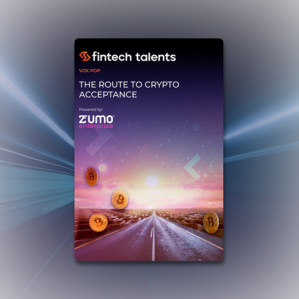Exploring the frontiers of programmable money
What can we do with programmable money? Ever since the ‘DeFi summer’ of 2020, we have known that digital assets hosted on public blockchains can be programmed to achieve a potentially wide range of financial applications: all the way from simple exchanges and borrow/lend operations to sophisticated new types of derivative assets. And more, do so in a globally open and friction-free way that opens up access and participation around the world.
Today, we find these same concepts finding wider and wider interest and application, not least in the existing financial world. One of these fast-evolving examples is the Bank of Thailand (BoT), which hopes to harness blockchain technology within the context of its own exploratory central bank digital currency, or CBDC, to unlock real-world utility in the financing of small and medium-sized enterprises (SMEs) within the country.
Zumo was delighted to be invited to input to the thinking around this sort of solution at the Point Zero Forum in Zurich, a prestigious gathering of central banks, regulators, and industry leaders to discuss emerging policy-technology issues. Here, fresh from the Bank of Thailand moderated round-table, are some of our key takeaways on the operational factors of realising these types of solution as presented by Zumo CFO Devina Paul.
The context: aiming for better SME financing
As the Bank of Thailand notes, in Thailand SMEs employ approximately 70% of the workforce, account for 35% of GDP, and more than 99% of the number of firms. Even though they are therefore important drivers of the economy, BoT stakeholder workshops indicate that working capital remains a key SME pain point – they cannot easily get funding even when they have invoice claims on large corporates for products already delivered.
In partnership with Siam Cement Group (SCG) and Digital Ventures Company Limited (DV), the Bank of Thailand has therefore taken steps to explore how Distributed Ledger Technology (DLT) can facilitate corporate Central Bank Digital Currency (CBDC) usage, with a focus on SME financing. The proposed solution: an invoice tokenisation system that can help SMEs secure financing by using invoice receivables as collateral.
This idea stems from integrating SCG’s existing Business-to-Payment (B2P) invoicing platform, connecting suppliers and large corporate buyers, with a hypothetical programmable CBDC issued via The Bank of Thailand. SME invoices are tokenised and made available to lenders to purchase at a given rate of return based on a system of smart contracts, and the CBDC used to broker the transactions.
Breaking down the legal and regulatory considerations
To understand this novel approach, we need to delve into four crucial areas:
- 1) The legal and operational considerations around the smart contracts facilitating the proposed invoice tokenisation.
- 2) The regulatory and supervisory approach to the tokens involved, which includes both digital currency (whether CBDC or another variant of programmable money) and tokenisation of real-world assets.
- 3) The appropriate Anti-Money Laundering (AML) and Know Your Customer (KYC) measures for participating parties.
- 4) The regulation applied to borrowing/lending activities and the platforms facilitating them.
1) Smart contracts: what’s at stake?
Smart contracts are at the heart of the proposed solution, automating key functions such as generating invoice tokens, swapping them for CBDC, issuing them to a lender, and redeeming tokens with interest. However, they raise crucial operational and legal questions, such as the treatment of fraudulent invoices, token swap failures, and supplier defaults. The important questions are the ‘what if’ ones – and, most crucially in this context, the protections platform participants may or may not have if a smart contract or its underpinning technology does not execute as intended.
Addressing these concerns requires clear terms of use and, potentially, separate legal agreements outside the blockchain environment, providing assurance and confidence to platform users through clarity on which elements are dependent on code and which may have a further legal underpinning. This is an area that has begun to be studied and categorised by the Law Commission in England & Wales in some detail in its work on ‘smart legal contracts’.
2) Tokens: balancing innovation and regulation
Clearly, tokenising invoices as a collateral asset may cause them to be viewed as a security or financial instrument, particularly if bundled to offer pooled investment products. Consequently, careful attention must be paid to the applicable securities laws – as well as any instructive previous examples that may already exist of the legal structures for offering tokenised real-world assets, including from the decentralised finance space, which also operates similar projects.
The other strand is the use of digital currencies, whether CBDC or, as also discussed by BoT, stablecoins. This raises the design decision of private vs public digital currency. While a CBDC is more suitable for domestic use, having the basis to be recognised as legal tender and therefore immediately usable, stablecoins are more globally integratable and currently hold the edge over CBDCs in terms of existing adoption. However, extending digital currencies to cross-border transactions introduces additional regulatory considerations, such as the travel rule for virtual asset service providers.
3) AML/KYC: ensuring compliance
Globally, it is a standard requirement to perform KYC on market participants and implement processes for ongoing AML monitoring. Although the proposed CBDC and business entity-based system likely reduce the risk of money laundering, decisions need to be made regarding the responsibility of KYC record-keeping and monitoring activity within the DLT system.
4) Borrowing and lending: a new regulatory space
Lastly, there is the question of whether the borrow/lend facilitation aspect would be treated as a regulated activity. In some jurisdictions, like the UK, operating a cryptoasset lending platform (in retail contexts) is currently suggested as a future regulated activity. It is crucial to consider local regulator oversight, required investor disclosures, and monitoring of collateral to maintain market integrity.
Coded interest rate setting is also an interesting area: to what extent should operators intervene if interest rates become prohibitively high and the solution therefore fails in its objective to provide affordable funding to SMEs? As we look into these factors, there is the need to balance interest rates that don’t deter SMEs and providing an acceptable rate of return to investors, while fulfilling the primary objective of securing effective financing routes for SMEs.
A path forward
Bank of Thailand’s initiative is emblematic of the increasing engagement from financial institutions and central banks themselves on the topic of digital assets – which, at its best, embraces innovation and seeks to solve recognisable real-world problems. From the discussion here, SME financing could be one such use case.
It is also a sign of the many fascinating and emerging questions to be answered in the months and years to come: the use cases for CBDCs; the permeation of digital assets into the real-world economy; the role that will be occupied by the increasing involvement of central banks and incumbent participants. How will this be achieved? Through permissionless and decentralised platforms, through centrally regulated and maintained venues, or through a world that connects both?
Whatever the case, the world of finance is changing – and blockchain looks here to stay.





















